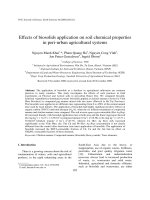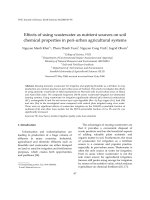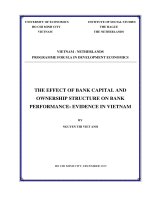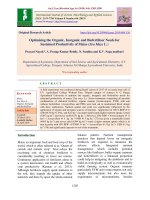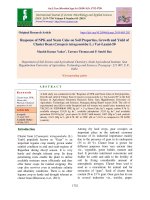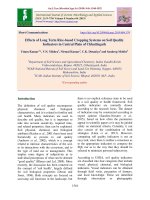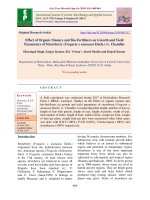Effect of organic, inorganic and bio fertilizers on soil physicochemical properties in rainfed maize-wheat cropping system of Jammu
Bạn đang xem bản rút gọn của tài liệu. Xem và tải ngay bản đầy đủ của tài liệu tại đây (220.48 KB, 7 trang )
Int.J.Curr.Microbiol.App.Sci (2019) 8(4): 2539-2545
International Journal of Current Microbiology and Applied Sciences
ISSN: 2319-7706 Volume 8 Number 04 (2019)
Journal homepage:
Original Research Article
/>
Effect of Organic, Inorganic and Bio fertilizers on Soil Physicochemical
Properties in Rainfed Maize-wheat Cropping System of Jammu
Bhoye Ranjanabai Chhagan, M.P. Sharma, K.R. Sharma, Abhijit Samanta,
Owais Ali Wani*, Dileep Kachroo, Manish Kumar, V.K. Razdan,
Vikas Sharma, A.K. Mondal and V.M. Arya
Division of Soil Science and Agricultural Chemistry, Sher-e-Kashmir University of
Agricultural Sciences and Technology, Chatha, Jammu- 180009 (J&K), India
*Corresponding author
ABSTRACT
Keywords
Organic, Inorganic
Bio fertilizers, Soil
Physicochemical
Properties
Article Info
Accepted:
17 March 2019
Available Online:
10 April 2019
An experiment was conducted during 2015-2016 in sandy loams at Jammu under the INM
in maize-wheat system. The results revealed that the application of recommended levels of
NPK to maize-wheat with FYM, VC and biofertilizers (Azotobacter and phosphate
solubilizing bacteria) resulted in grain 66.53 per cent and straw 13.00 per cent increase
over control in maize and wheat yields, respectively. Increasing levels of 50%
N+recom.P+K+S+Zn+B +VC+Azoto+PSB significantly increased the yield of both the
crops. Integrated use of organic, inorganic and biofertilizers improved the soil status of
available N, P, K, S over the initial values. A declining trend (70.05, 9.14, 110.13, 8.14 kg
ha-1) from the initial value of available nutrients indicates a considerable mining of INM
from the soil and suggest the need to adopt judicious organic, inorganic and biofertilizers.
Introduction
Maize-wheat system in the sub-mountainous
western Himalayan region of India comprises
the state of Jammu and Kashmir. The
contribution of this cropping system to total
food grain production of the country is
considerably large, amounting to 36.49% of
wheat (93.90 million tonnes) and 8.38% of
maize (21.57 million tonnes) which makes it
one of the predominant cropping systems in
India (Ramesh et al., 2014). However, in spite
of the significant achievement made in
research and development productivity of
Maize-wheat system is still very low. Maizewheat is dominant cropping sequence
covering 2, 21,773 and 2, 88,842 ha area,
respectively under rainfed condition of
Jammu region. The average productivity of
this system is being 3.44 tonnes/ha which is
quite low as compared to national average of
5.6 tonnes/ha. It may be due to little use of
organics, poor soil fertility because of coarse
texture, and low organic matter content,
heavy requirement of nutrients by these crops.
Out of these, imbalanced application of
nutrients is a major factor affecting crop
productivity and soil characteristics in the
2539
Int.J.Curr.Microbiol.App.Sci (2019) 8(4): 2539-2545
region. In the present day of intensive
agriculture, the crop plant is unable to use all
the applied nutrients in its short lifespan.
Therefore, fertilizer scheduling should be
done on the bases of cropping sequence rather
than individual crop to utilize residual plant
nutrients for their efficient, economical and
judicious use
The occurrence of deficiency of secondary
nutrient viz., S and micronutrients viz., Zn
and B is being observed increasingly under
heavy feeder maize-wheat cropping sequence.
Balanced fertilization to any crop or cropping
sequence played vital role to attain optimum
crop yield, enhance crop quality, corrects
inherent soil nutrient deficiencies, sustain soil
fertility, improve nutrient and water use
efficiency, avoid damage to the environment
and restore fertility of land that has been
degraded by wrong and exploitative practices
in the past. Adoption of such practices may
influence carbon sequestration in soil because
of their progressive effect on crop growth.
Balanced nutrient management on the bases
of soil testing can be achieved in better way
by adopting integrated application of organic
and inorganic for enhancing soil quality, input
use efficiency and crop productivity which is
the all most important for food and nutrient
security. Maize-wheat is one of the most
important double cropping systems being
practiced under rainfed condition of Jammu
region. Both, being exhaustive crops, required
a huge amount of nutrients for producing
higher yield. The best option in respect to
balanced application of nutrients through
organic and inorganic may come out for
making
the
judicious
fertilizer
recommendations for realizing higher
inherent yield potentials of both the crops as
well as the outcome of this investigation will
facilitate the stakeholders to maximize crop
yield, nutrient use efficiency, water use
efficiency, and soil quality under rainfed
conditions of Jammu region.
Materials and Methods
The present investigation is a part of an
ongoing experiment with maize-wheat
cropping system in progress since kharif and
rabi 2015 and 2016 at Advance center for
rainfed
Agriculture
Rakh
Dhainsar,
SKUAST-Jammu and Department of Soil
Science and Agricultural Chemistry, Chatha,
Jammu Jammu and Kashmir (320 39’ N and
74058 E). Dhainsar, Jammu has a sub-tropical
climate with a characteristic feature dry and
cold winter. In winter season i.e Oct to March
the temperature 2 to 20 0c and the relative
humidity 41 to 65%.Gernerally, dry and warm
weather prevails during the months of March
to June. The temperature in the month of May
reaches as high as 48 0C. Monsoon season
extends from first of July to mid-September.
Total annual rainfall varies from 1049.2 mm
to 1304 mm with the mean value of around
mm. The length of growing period of both the
crops ranges from 200 to 210 days. The soil
of the experimental field is sandy loam in
texture having pH (6.67), Bulk density (1.64
Mg m-3), Water holding capacity(11.01 %),
organic carbon (2.05g kg-1) and available
nitrogen (70.05kg ha-1), Phosphorus (9.14 kg
ha-1), Potassium (110.13 kg ha-1) were,
Sulphur (8.14 kg ha-1) and Zinc (0.36 mg
kg-1), Boron (0.34 mg kg-1), respectively.
There were eleven treatments viz., T1 Control,
T2 Recommended NPK T3 Reco. NPK+ S +
Zn + B, T4 50% N + Reco. P + K + S + Zn +
B + 50% N through FYM, T5 50%N + Reco.
P + K + S + Zn + B + 50% N through VC, T6
75% N + Reco. P+ K +S +Zn + B+25% N
through FYM, T 7 75% N + Reco. P +K +S
+Zn +B+25% N through VC, T8 50% N+
Reco. P+ K +S +Zn + B + 50% N through
FYM +Azot +PSB, T9 50% N + Reco. P +K
+S +Zn +B+ 50% N through VC + Azot +
PSB,T1075%N+Reco.P +K +S +Zn+ B+ 25%
N through FYM +Azto +PSB, T11 75% N +
Reco. P +K +S, Zn + B+ 25% N through VC
+ Azot +PSB. Each treatment was replicated
2540
Int.J.Curr.Microbiol.App.Sci (2019) 8(4): 2539-2545
thrice in a randomized block design. The
recommended P, K, S, Zn and B doses, based
on initial soil test, maize and wheat. The
sources of N through FYM and VC were
incorporated treatment. (Sowing time) in the
soil sowing time of maize and wheat during
kharif and rabi season since 2015-16.
Treatments T8, T9, T10 and T11 involved
inoculation by Azotobacter and PSB culture
(@ 5g kg-1 seed). Maize- wheat varieties used
were Vivak Maize-25 and PBW-175
respectively, maize in general was sown on
the set of monsoon (third week of July) as
rainfed crop during kharif and wheat in the to
fourth week of October as irrigation crop
during rabi. The maturity and yield data were
recorded after harvested at maturity and yield
data were recorded after threshing. Soil
samples from 0-15 cm depth were collected
after harvest of maize in the 2th cropping year
(2015-16 and 2017) and were analyzed for
available N by alkaline permanganate method
(Subbiah and Asija, 1956), available P (Olsen
et al., 1954) and available K (ammonium
acetate extract). All observations were
recorded for both the crops and soil properties
were analyzed statistically
Results and Discussion
The highest magnitude of BD after harvesting
of maize and wheat was recorded in T1 (1.54)
to lowest in T6 (1.41) and T1 (1.52) to lowest
in T6 (1.40). The highest BD may be due to
high sand content and poor organic matter and
clay content whereas lowest BD in T6 (1.41)
could be due to addition of organic carbon
and significant improvements of addition of
organic, inorganic and biofertilizers which
collectively influenced the BD in soils (Table
1–4).
Table.1 Integrated effect of inorganic, organic and biofertilizers on bulk density (mg m-3) of soil
after harvesting maize wheat cropping system
Ist year
Sr.No
T1
T2
T3
T4
T5
T6
T7
T8
T9
T10
T11
1.54
1.50
1.49
1.46
II nd year
(mg m-3)
1.52
1.52
1.50
1.45
1.53
1.51
1.50
1.46
1.51
1.50
1.47
1.42
II nd year
(mg m-3)
1.53
1.51
1.46
1.45
1.48
1.47
1.48
1.40
1.41
1.41
1.41
1.38
1.40
1.46
1.47
1.47
1.45
1.44
1.45
1.47
1.46
1.46
1.44
1.40
1.42
1.45
1.43
1.44
1.46
1.42
1.44
1.41
1.42
1.41
1.43
1.40
1.42
1.42
1.41
1.41
1.46
1.40
1.43
0.022
0.011
0.008
0.003
0.010
0.014
0.042
0.012
0.037
0.064
1.51
0.033
1.53
0.025
1.52
Treatments
Control
Recommended NPK
Reco. NPK+ S + Zn + B
50% N + Reco. P + K + S + Zn + B +
50% N through FYM
50% N + Reco. P + K + S + Zn + B +
50% N through VC
75% N + Reco. P+ K +S +Zn + B+25%
N through FYM
75% N + Reco. P +K +S +Zn +B+25%
N through VC
50% N+ Reco. P+ K +S +Zn + B +
50% N through FYM +Azot +PSB
50% N + Reco. P +K +S +Zn +B+ 50%
N through VC + Azot + PSB
75%N+Reco.P +K +S +Zn+ B+ 25% N
through FYM +Azto +PSB
75% N + Reco. P +K +S, Zn + B+ 25%
N through VC + Azot +PSB
± S.E.(m)
C.D. (P=0.05)
2541
Overall
Ist year
Overall
1.52
1.51
1.47
1.44
Int.J.Curr.Microbiol.App.Sci (2019) 8(4): 2539-2545
Table.2 Integrated effect of inorganic, organic and biofertilizers on water holding capacity (%)
soil after harvesting maize wheat cropping system
9.5
Treatments
T1
T2
T3
T4
T5
T6
T7
T8
T9
T10
T11
Control
Recommended NPK
Reco. NPK+ S + Zn + B
50% N + Reco. P + K + S + Zn + B + 50%
N through FYM
50% N + Reco. P + K + S + Zn + B + 50%
N through VC
75% N + Reco. P+ K +S +Zn + B+25% N
through FYM
75% N + Reco. P +K +S +Zn +B+25% N
through VC
50% N+ Reco. P+ K +S +Zn + B + 50% N
through FYM +Azot +PSB
50% N + Reco. P +K +S +Zn +B+ 50% N
through VC + Azot + PSB
75%N+Reco.P +K +S +Zn+ B+ 25% N
through FYM +Azto +PSB
75% N + Reco. P +K +S, Zn + B+ 25% N
through VC + Azot +PSB
± S.E.(m)
C.D. (P=0.05)
Ist year
(%)
11.25
11.34
11.37
12.51
IInd year
11.29
11.43
11.94
13.32
11.27
11.39
11.66
12.92
11.11
11.15
11.19
12.20
IInd year
(%)
11.19
11.33
11.63
12.65
11.34
12.41
11.88
11.23
11.26
11.25
11.56
11.39
11.48
11.19
11.30
11.24
11.27
11.24
11.26
11.08
11.15
11.19
14.31
14.29
14.30
13.62
13.88
13.75
13.08
13.44
13.26
12.98
13.30
13.14
11.62
11.68
11.65
11.32
11.55
11.44
11.54
11.64
11.59
11.22
11.42
11.32
0.07
0.010
0.14
0.042
0.19
0.037
0.09
0.27
0.16
0.49
0.07
0.22
Overall
Ist year
Overall
11.15
11.24
11.41
12.43
Table.3 Integrated effect of inorganic, organic and biofertilizers on soil reaction (1:2.5) soil after
harvesting maize wheat cropping system
Ist year
Sr.No
T1
T2
T3
T4
T5
T6
T7
T8
T9
T10
T11
6.54
6.59
6.56
6.54
IInd year
(1:2.5)
6.61
6.58
6.50
6.56
6.58
6.59
6.53
6.55
6.55
6.53
6.58
6.52
IInd year
(1:2.5)
6.51
6.49
6.48
6.47
6.42
6.33
6.38
6.48
6.47
6.48
6.46
6.33
6.40
6.47
6.45
6.46
6.48
6.38
6.43
6.45
6.41
6.43
6.50
6.44
6.47
6.42
6.48
6.45
6.49
6.50
6.50
6.41
6.46
6.44
6.42
6.39
6.41
6.39
6.44
6.42
6.22
6.42
6.32
6.43
6.39
6.41
0.02
0.06
0.03
0.09
0.05
0.15
0.02
0.07
0.01
0.04
0.02
0.08
Treatments
Control
Recommended NPK
Reco. NPK+ S + Zn + B
50% N + Reco. P + K + S + Zn + B + 50%
N through FYM
50% N + Reco. P + K + S + Zn + B + 50%
N through VC
75% N + Reco. P+ K +S +Zn + B+25% N
through FYM
75% N + Reco. P +K +S +Zn +B+25% N
through VC
50% N+ Reco. P+ K +S +Zn + B + 50% N
through FYM +Azot +PSB
50% N + Reco. P +K +S +Zn +B+ 50% N
through VC + Azot + PSB
75%N+Reco.P +K +S +Zn+ B+ 25% N
through FYM +Azto +PSB
75% N + Reco. P +K +S, Zn + B+ 25% N
through VC + Azot +PSB
± S.E.(m)
C.D. (P=0.05)
2542
Overall
Ist year
Overall
6.53
6.51
6.53
6.50
Int.J.Curr.Microbiol.App.Sci (2019) 8(4): 2539-2545
Table.4 Integrated effect of inorganic, organic and biofertilizers on organic carbon (g kg-1) soil
after harvesting maize wheat cropping system
Ist year
Sr.No
T1
T2
T3
T4
T5
T6
T7
T8
T9
T10
T11
Overall
Ist year
2.22
2.27
2.35
3.02
IInd year
(g kg-1)
2.28
2.34
2.41
3.44
Overall
2.23
2.28
2.37
3.09
IInd year
(g kg-1)
2.26
2.33
2.45
3.48
2.25
2.31
2.38
3.23
2.82
3.23
3.03
3.04
3.06
3.05
2.49
2.68
2.58
2.79
2.94
2.87
2.51
2.55
2.53
2.64
2.79
2.72
4.11
4.12
4.12
4.14
4.19
4.17
4.09
4.02
4.06
4.00
4.05
4.03
2.69
2.85
2.77
2.79
3.00
2.89
2.66
2.86
2.75
2.67
2.69
2.68
0.03
0.11
0.13
0.40
0.16
0.53
0.07
0.20
0.06
0.20
0.03
0.11
Treatments
Control
Recommended NPK
Reco. NPK+ S + Zn + B
50% N + Reco. P + K + S + Zn + B
+ 50% N through FYM
50% N + Reco. P + K + S + Zn + B
+ 50% N through VC
75% N + Reco. P+ K +S +Zn +
B+25% N through FYM
75% N + Reco. P +K +S +Zn
+B+25% N through VC
50% N+ Reco. P+ K +S +Zn + B +
50% N through FYM +Azot +PSB
50% N + Reco. P +K +S +Zn +B+
50% N through VC + Azot + PSB
75%N+Reco.P +K +S +Zn+ B+
25% N through FYM +Azto +PSB
75% N + Reco. P +K +S, Zn + B+
25% N through VC + Azot +PSB
± S.E.(m)
C.D. (P=0.05)
These observation corroborate the results
obtained by Rehman et al., 2017 and
Thangasamy et al., 2017.
improvements in soil pH under treatments,
might be due to integrated application of
organic, inorganic and biofertilizers which
brought significant enhancement in soil pH
under aforesaid treatments. were These
observation are in agreement with the results
of Mishra et al., (2008), Chesti et al., (2013)
and Rehman et al., (2017).
The highest WHC after harvesting of maize
and wheat was found in T8 (14.31) to lowest
in T1 (11.25) and T8 (13.62) to lowest in T1
(11.11)can be due to addition of organic,
inorganics and biofertilizers which catalyzed
to enhanced organic carbon, and thereby
increasing water holding capacity these
findings are corroborate the observation of
Sharma et al., (2017).
The highest value of organic carbon after
harvesting of maize and wheat crop was
recorded in overall organic carbon found
highest in T8 (4.12) to lowest in T1 (2.25)
and highest in T8 (4.17) to lowest in T1
(2.26). The highest value of organic carbon
in T8 (4.12) may be due to integrated uses of
organic, inorganic and biofertilizers which
released its higher uptake whereas lowest
The highest pH of soil after harvesting of
maize and wheat crop was noticed in T2
(6.59) to lowest T11 (6.22) and T3(6.58) to
lowest in T10 (6.39) the significant
2543
2.26
2.31
2.41
3.29
Int.J.Curr.Microbiol.App.Sci (2019) 8(4): 2539-2545
value of organic carbon may be due its
scanty retention. The decreasing pattern of
overall organic carbon under different
treatments might be due to its slow release
pattern responsible for decreasing trend.
These observations are supported by Kumari
et al., (2011) and Lakaria et al., (2012).
Kumar, M., Jha, P. and Biswas, A.K.
2012. Soil organic carbon pools and
indices under different land use
systems in vertisols of central India.
Journal of the Indian Society of Soil
Science. 65: 125-131.
Lindsay, W.L., and Norwell, W.A. 1978.
Development of DTPA soil test for
zinc, iron, manganese and copper.
Soil Science Society of America
Journal 42: 421-428.
Olsen, S.R., Cole, C.V., Watanable, F.S. and
Dean, L.A. 1994 Extermination of
available phosphorus in soils by
extraction with sodium bicarbonate.
USDA Circular 939.
Mishra, B., Sharma, A., Singh, S.K., Singh,
Prasad, J. and Singh, B.P. 2008.
Influence of continuous application
of amendments to maize-wheat
cropping system on dynamics of soil
microbial biomass in alfisol of
Jharkhand. Journal of the Indian
Society of Soil Science. 56 (1):71-75.
Olsen, S.R., Cole, C.V., Watanable, F.S. and
Dean, L.A. 1994 Extermination of
available phosphorus in soils by
extraction with sodium bicarbonate.
USDA Circular 939.
Page, A.L. Miller, R.H. and Keeny, D.R.
(eds.) 1982. Agronomy Monograph
9, ASA/SSSA Publication, Madison,
Wisconsin
Piper, C.S., 1966. Soil and plant Analysis.
Hans Publisher. Bombay, India.
Rehman, N.Z., Ram, D., Wani, J.A. and
Maqbool, M. 2017. Characterization,
classification and evaluation of
cultivated soils under different top
sequences in Pulwama district of
Kashmir valley. Journal of the
Indian Society of Soil Science. 65
(3):239-247.
Sharma, M.P., Sharma, Mondal, A.K.,
Bhoye, R. C., Samantha A., Rai1,
A.P., Arya1, V.M., and Sharma,
It is concluded that over two year of maizewheat cropping system respect the
treatments receiving integrated use of
organic, inorganic and biofertilizers
improved the soil status of soil properties
viz, pH, Organic carbon, water holding
capacity,
bulk
density
improved
significantly under treatments received
integrated nutrient application.
References
Chesti, M.H., Kohli, A. and Sharma A.K.
2013. Effect of integrated nutrient
management on yield of and nutrient
uptake by wheat (Triticum aestivum)
and
soil
properties
under
intermediate zone of Jammu and
Kashmir. Journal of the Indian
Society of Soil Science. 61 (1):1-6.
Chesnin, L., and Yein, C.H. 1951.
Turbidimetric
determination
of
available sulphur. Soil Science of
America Proceedings 15, 149-151.
Chhonkar, P.K., Bhadraray, S., Patra, A.K.
and Purakayastha, T.J. 2002.
Practical Manual on Soil Biology
and
Biochemistry.
Indian
Agricultural Research Institute, New
Delhi-110 012. Pp. 57.
Ghuman, B.S., and Sur, H.S. 2006. Effect of
manuring on soil properties and yield
of rainfed wheat. Journal of the
Indian Society of Soil Science. 54(1):
6-11
Jockson, M.L. 1973. Soil Chemical
Analysis, Prentice hall of India Pvt.
Limited. Lakharia, B.L., Patne,
2544
Int.J.Curr.Microbiol.App.Sci (2019) 8(4): 2539-2545
K.R.2017. Soil Characterization of
Advance Research Centre for Rain
Fed Agriculture Farm of Sher-eKashmir University of Agricultural
Sciences and Technology RakhDhinsar,
Jammu(J&K).
International Journal of Plant & Soil
Science. 20(1): 1-7, 2017
Subbiah, B.V., and Asija, G. L. 1956. A
rapid procedure for the determination
of available nitrogen in soils.
Current Sciences, 25: 259-68.
Thangasamy, A., Singh, D., Dwivedi, B.S.,
Chakraborty, D., Tomar, R.K. and
Meena, M.C. 2017. Soil organic
carbon, hydraulic properties and
yield of maize and wheat under long
term fertilization in an inceptisol.
Journal of the Indian Society of Soil
Science.65 (2):189-198.
Williams, C.H., and Heidel, H. 1952. Soil
analysis methods as used in Iowa
State
College,
Soil
Testing
Laboratory, Iowa State College Bull.
57: 1-131.
How to cite this article:
Bhoye Ranjanabai Chhagan, M.P. Sharma, K.R. Sharma, Abhijit Samanta, Owais Ali Wani,
Dileep Kachroo, Manish Kumar, V.K. Razdan, Vikas Sharma, A.K. Mondal and Arya, V.M.
2019. Effect of Organic, Inorganic and Bio fertilizers on Soil Physicochemical Properties in
Rainfed Maize-wheat Cropping System of Jammu. Int.J.Curr.Microbiol.App.Sci. 8(04): 25392545. doi: />
2545
